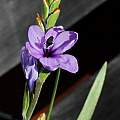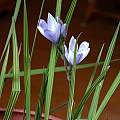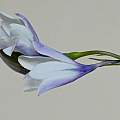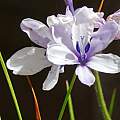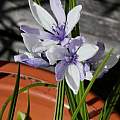Babiana is a large genus in the family Iridaceae from southern Africa. This genus was revised in 2007 by Peter Goldblatt and John C. Manning. Species i-p are found on this page.
Babiana species a-h - Babiana species r-si - Babiana species sp-z - Babiana index
Babiana inclinata Goldblatt & J.C.Manning is found on damp clay flats and lower slopes in the western Cape from Porterville to Hopefield. It grows from 15 to 30 cm high with an inclined spike and lanceolate pleated leaves in a loose basal fan. The flowers are in an inverted inclined spike with the larger dorsal tepal horizontal and held somewhat apart from the others. Flowers are blue to violet with the suberect lower tepals often and dorsal tepals sometimes cream-colored. The lower tepals have black or reddish markings in the lower third. Anthers and pollen are purple, lilac, or white. This new species is sometimes confused with Babiana angustifolia which also has inverted flowers, but that species has tepals that are subequal and more cupped and black anthers. Photos taken September 2006 near Clanwilliam in the Western Cape of what I think is this species by Mary Sue Ittner.
Babiana karooica Goldblatt & J.C.Manning occurs only in the Little Karoo in gravelly soils (from Oudtshoorn to De Rust). Although it is locally abundant in some of those locations, it is at risk as more land is lost to urban and agricultural development. It has very fragrant mauve to light blue flowers, marked with white and dark blue and flowers in late autumn and winter. The leaves and flowers of this rare endemic look similar to Babiana sambucina which also occurs in the Little Karoo, but the Babiana karooica flowers are smaller and have an earlier flowering period. Height range: 30-45 cm. Photos from the book Plants of the Klein Karoo courtesy of Jan and Anne Lise Schutte-Vlok.
Babiana leipoldtii C.J.Lewis grows in seasonally damp sandy flats near Darling. Most of its habitat has been converted to agriculture, so it remains in only a handful of sites, and it is listed as critically endangered, meaning it is at high risk of extinction. Plants are 10 to 18 cm tall with lanceolate, pleated, hairy leaves, usually reaching to the base of the spike. Flowers are actinomorphic and blue-violet, somewhat darker in the center and sometimes with red markings in the lower third of the tepals. Photos below from iNaturalist taken by Nick Helme and Jacques van der Merwe near Darling and Malmesbury in July and shared under a CC BY-NC license.
Babiana lineolata Klatt is distributed in the western Cape where it grows on mostly seasonally wet sandy flats. Growing from 13 to 25 cm high, it has rigid narrow deeply pleated hairy leaves, short bracts, and 4 to 12 pale blue odorless flowers in an erect spike. The lower lateral tepals are white to yellow with a blue tip and united below to form a prominent lip. Plants usually grow in dense colonies. The usual time for flowering is September to early October. Photo taken by Rachel Saunders in the Kouebokkeveld Mountains, at the top of the Gydo pass where plants were flowering with pink Drosera cistiflora and yellow Geissorhiza louisabolusiae. This area is colder and higher so there were still flowers in late October 2016.
Babiana melanops Goldblatt & J.C.Manning is distributed in the Western Cape where it is mostly found on gravel flats and slopes on hills between Darling and Mamre on the coast, but also inland on rocky sandstone flats in fynbos in the Tulbagh Valley. It is at risk. Growing 10 to 20 cm high, it has erect lanceolate softly hairy leaves and radially symmetric violet to purple flowers with a dark center with arrow shaped blackish anthers on an erect spike. Flowers in different populations are different in the length of the tube. In addition some are scented with abundant nectar and some are unscented with only traces of nectar. This species resembles Babiana villosa, but differs in having a suberect stem and tepals that are narrowed at the claw and spread horizontally when fully open. It flowers August to September. The first photo from Rod Saunders. The next two photos were taken by Mary Sue Ittner.
Babiana montana G.J.Lewis is a short plant found on sandstone and limestone slopes. It has mauve flowers with yellow and purple markings and flowers in winter. Height: 6-7 cm. high. Photos were taken in the Overberg by Cameron McMaster near Napier and at Boskloof.
Babiana mucronata (Jacq.) Ker Gawl. is found on rocky sandstone slopes and flats in the northwest Cape. Plants grow from 5 to 18 cm high. Leaves are sword-shaped to lanceolate, pleated, and hairy with velvety margins. Flowers are pale to dark violet blue arranged in a compact, suberect spike. The lower tepals are white to cream to yellow edged with violet. It flowers August to September. Babiana ssp. mucronata is usually 15 to 35 cm high with the spike exceeding the leaves and a longer tube than the other subspecies. Photo from Audrey Cain.
Babiana mucronata ssp. minor (G.J.Lewis) Goldblatt & J.C. Manning, syn. Babiana mucronata var. minor G.J.Lewis, syn. Babiana klaverensis G.J.Lewis, is found on rocky slopes and sandstone in the Northern and Western Cape. It grows from 5 to 8 cm with the spike overtopped by leaves. It has 3 to 6 violet to mauve flowers in a compact spike with tepals joined to each other. It is distinguished from the other subspecies by being dwarf instead of tall and having a shorter perianth tube. The picture below from Alan Horstmann is of a plant that was grown as Babiana klaverensis. The second photo is from Rod Saunders.
Babiana nana (Andrews) Spreng. as the name implies is a low (6 to 15 cm tall) winter growing species from the Cape where it is usually found on sandy coastal flats and dunes and blooms late winter-early spring. Leaves vary from ovate to narrowly lanceolate to almost linear. It has a nice rose violet fragrance. Flowers are blue or violet, rarely pale pink, with white markings on the lower lateral tepals. The hallmark of this species is that the flowers are disproportionately large compared to the leaves. Photos 1-2 by Alan Horstmann and photos 3-6 by Nhu Nguyen. The form grown by Nhu Nguyen is prone to leaf damage with too much rain. The advantage is that it offsets very strongly.
Babiana nana ssp. maculata (Klatt) Goldblatt & J.C. Manning is a new combination in the latest revision for narrow leaved (5 to 15 mm) populations called Babiana nana var. angustifolia (Eckl.) G.J.Lewis in the past. This subspecies is found on sandy coastal flats and dunes in the Southwestern Cape. The flowers are in shades of blue to violet and the time of bloom is late August and September. Photos 1 to 5 below by Mary Sue Ittner are of plants that make good container plants. The flowers smell like cinnamon. The fifth photo shows cormels in the stem. The last photo by M. Gastil-Buhl shows corms grown by Jim Duggan on a 1 cm grid.
Babiana nana ssp. nana grows on sandy coastal flats and dunes from Saldanha to Milnerton. Leaves are ovate to broadly lanceolate (15 to 35 mm) and held obliquely or sometimes at right angles to the sheaths. It flowers mainly in September and is violet scented. Photo from Rod Saunders.
Babiana nervosa (Lam.) Goldblatt & J.C.Manning, syn. Babiana stricta (Aiton) Ker Gawl., has purple, blue, white or yellow flowers with stems overtopping the leaves and centrally placed dark anthers, growing 10-20 cm tall. It grows on clay soils in renosterveld from Piketberg to Swellendam and has been used in breeding to create many of the garden hybrids. The first three photos by Bob Rutemoeller and Mary Sue Ittner were taken August 2006 in Tulbagh.
The first photo taken by Mary Sue Ittner is of a garden plant. The second photo is from Alan Horstmann. The last photo of seed by David Pilling.
The photos below from Mary Sue Ittner are probably hybrids from this species. They are descendants of a batch of seeds described as mixed species. They have been good garden plants, growing and increasing in the ground or as container plants. One flowers a couple of weeks before the other.
Babiana noctiflora J.C.Manning & Goldblatt is found on rocky outcrops in renosterveld in the Western Cape south of Malmesbury. Growing from 18 to 30 cm, it has pleated, lanceolate, softly hairy leaves reaching to the middle of the spike. Flowers are bilaterally symmetrical, creamy yellow with lower lateral tepals deep yellow and violet scented. It is similar to Babiana odorata but has larger flowers and a much longer tube. It flowers September to October and is unusual as the flowers remain open and scented at night and are pollinated by moths. The first photo from Rod Saunders. The second photo from iNaturalist was taken by janeennichols in September in the Western Cape and shared under a CC BY-NC license.
Babiana odorata L. Bolus grows in clay soils in Renosterveld in the northwest and southwest Cape. Flowers are yellow to creamy yellow with broad yellow blotches on the lower tepals and with a spicy violet fragrance. Height: 5-15 cm. Photos 1-2 were taken by Alan Horstmann and photo 3 was taken by Rod Saunders. Photos 4-5 were taken by Nhu Nguyen at the UC Botanical Garden.
Babiana patersoniae L.Bolus, Moth Bobbejaantjie, is found on clay and loamy slopes in grassland or renosterveld in the Western and Eastern Capes. Leaves are sword-shaped, pleated, and hairy. Flowers are white to pale blue to mauve with the lower lateral tepals of some partly cream-colored to yellow with darker red to purple markings near the base. Anthers are blue to blackish, linear to more or less arrow-shaped. Flowers are strongly scented of cloves, especially at night. John Manning writes that this species is probably pollinated by moths who could find the flowers at night because of their light color and fragrance. Height range: 15-25 cm. The first photo by Sheila Burrow shows one she was growing in Western Australia. The other photos were taken by Mary Sue Ittner.
The first five photos by Cameron McMaster of plants growing at Boskloof, Bredasdorp, and near Napier in the Overberg. The last photo was taken by Rod Saunders.
Babiana patula N.E.Br. has flowers that are mauve to blue with yellow markings or all yellow or white and are very fragrant. It has hairy pleated leaves and short stems, often bent sideways. Height: 2-8 cm. It grows on clay flats and lower slopes from the Southwestern Cape, the Southern Cape and to Langeberg Mountains. The first photo was taken by Mary Wise. The second photo was taken by Alan Horstmann. The rest of the photos were taken in habitat by Cameron McMaster near Napier in the Overberg.
The first three photos by Bob Rutemoeller show one blooming in the Little Karoo in September 2003, one flowering in Bontebok National Park the same month, and a yellow flowered one blooming near Villiersdorp August 2006. The fourth photo taken by Ragnhild Crawford is of a rare white flowered plant. The fifth photo was taken by Rod Saunders. The last photo from the book Plants of the Klein Karoo courtesy of Jan and Anne Lise Schutte-Vlok.
Babiana praemorsa Goldblatt & J.C.Manning is a species named in 2004. It grows on dolerite outcrops, often in rock crevices in the Northern Cape (Calvinia from the Hantamsberg to near Nieuwoudtville). It is one of the four Babiana species with truncate wedge-shaped leaves. Flowers are dark violet with white to cream colored spear shaped marks often edged with red or dark blue on the lower lateral tepals. It has a longer tube than Babiana flabellifolia and tepals that spread horizontally and short filaments unlike Babiana cuneata which has ascending tepals and longer filaments. Height: 15 cm. Photos 1-2 from Mary Sue Ittner taken near Nieuwoudtville in September 2001 and 2006 she thinks are this species. Photos 3-4 from Cameron McMaster were taken September 2011. The last two photos from Alan Horstmann were taken on the top of Hantam, Calvinia.
Babiana purpurea (Jacq.) Ker Gawl. has fragrant pink or purple flowers and is found in the southwest Cape on clay slopes and flats in renosterveld. It grows from 10 to 20 cm high and flowers August to September. The first photo taken at Drayton siding near Caledon September 2003 by Bob Rutemoeller and photos two through four by Cameron McMaster taken at Bot River, and Boskloof in the Overberg. The fifth photo from Alan Horstmann. The last photo was taken by Rod Saunders.
The first two photos from Alan Horstmann. The next photos by Mary Sue Ittner are of plants grown from seed that flower early in California, January or February. The last photo shows the corms on a 1 cm grid.
Babiana pygmaea (Burm.f.) Baker has large yellow flowers with a dark purplish or brown center and grows on gravelly flats in the southwest Cape. It grows to 10 cm high, has lanceolate, hairy leaves and flowers August to September. It is a rare plant now only found in the Hopefield district. Photos by Mary Sue Ittner and Bob Rutemoeller. The first photo shows a plant that was grown from seed and subsequently was lost. The next two photos were taken in South Africa where Rod Saunders and Rachel Saunders are having more success growing this species. The last two photos are from Alan Horstmann.
Babiana species a-h - Babiana species r-si - Babiana species sp-z - Babiana index











